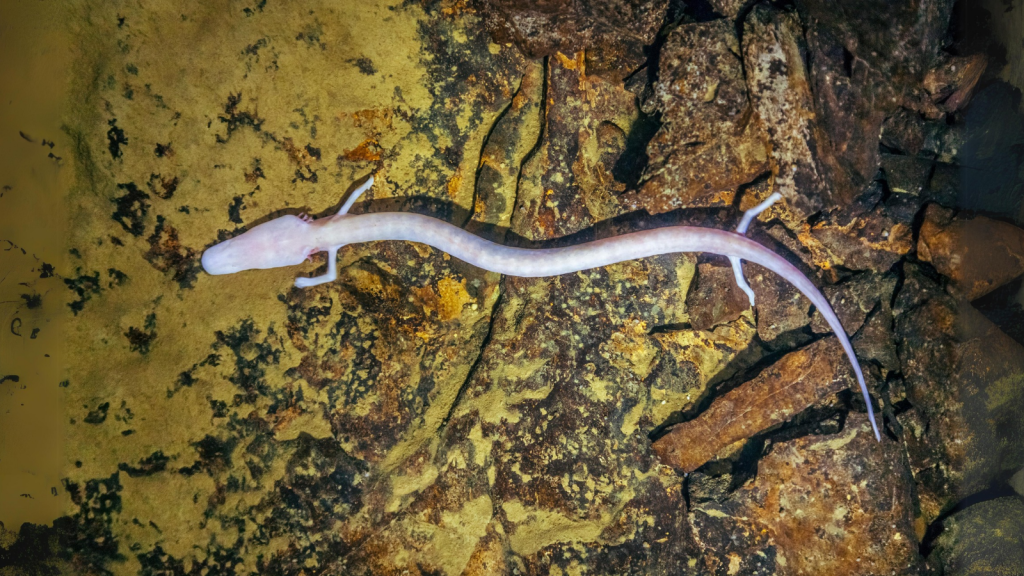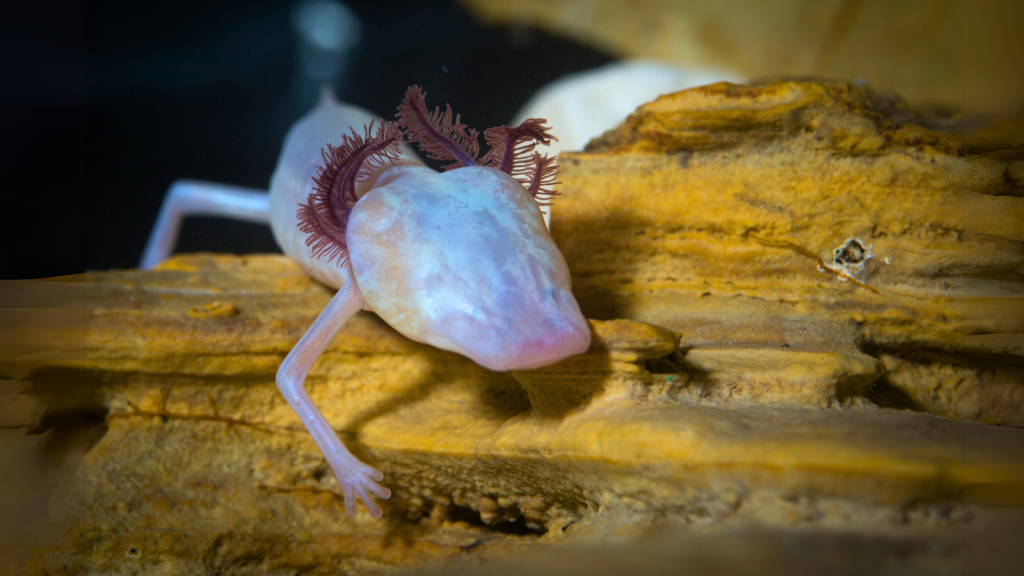Deep beneath our feet, a hidden world teems with life. In the dark recesses of caves, creatures have evolved to thrive in conditions that would seem alien to us. These subterranean dwellers have adapted to life without sunlight, developing unique features to navigate and survive in their pitch-black homes. From blind fish to translucent crustaceans, the cave ecosystem hosts a range of fascinating animals. Let’s explore some of the most remarkable cave-dwelling creatures, rarely seen by human eyes.
Olm: The Human Fish

The olm, also known as the proteus, is a pale, snake-like amphibian found in the caves of southeastern Europe. With its tiny, underdeveloped eyes and external gills, this creature seems almost otherworldly. Olms can go without food for years and have a lifespan of up to 100 years. These remarkable creatures can also regenerate lost limbs, making them a subject of interest for medical researchers.
Giant Cave Centipede: A Metre-Long Hunter

Stretching up to 35 centimetres in length, the giant cave centipede is a fearsome predator of the underground world. With powerful venom and dozens of legs, it scuttles through cave systems in search of prey. These centipedes can even catch and eat small bats. Their excellent sense of touch compensates for their poor eyesight, allowing them to navigate and hunt effectively in total darkness.
Kauai Cave Wolf Spider: A Sightless Stalker

This eyeless spider, found only in a handful of caves on the Hawaiian island of Kauai, hunts by feeling vibrations in the air and ground. Despite its lack of vision, it’s an efficient predator, using its keen senses to catch cave crickets and other small invertebrates. The Kauai cave wolf spider is critically endangered, with only a few hundred individuals remaining in the wild.
Texas Blind Salamander: Pale and Peculiar

With its ghostly white skin and bright red external gills, the Texas blind salamander is a striking sight. Found only in the Edwards Aquifer in Texas, these small amphibians have evolved to live their entire lives in underground waters. They have an acute sense of smell and can detect chemicals in the water, which helps them find food and avoid predators.
Cave Crayfish: Colourless Crustaceans

These pale, eyeless crayfish have adapted to life in complete darkness. They use their long antennae to feel their way around cave streams and pools. Some species of cave crayfish are known to live for several decades. Their lack of pigmentation is a result of living in an environment without light, where colour serves no purpose.
Tumbling Creek Cavesnail: Tiny and Threatened

This minute mollusc, measuring just a few millimetres across, is found only in a single cave system in Missouri. The Tumbling Creek cavesnail plays a crucial role in its ecosystem, helping to keep the cave waters clean by feeding on decaying organic matter. Scientists monitor its population closely, as changes in its numbers can indicate shifts in water quality and overall cave health.
Kaua’i Cave Amphipod: A Translucent Shrimp

This tiny, see-through crustacean looks like a miniature shrimp. It’s so rare that it was only discovered in 1992 and is known to exist in just five caves on the Hawaiian island of Kaua’i. The amphipod’s transparent body allows it to blend in with its watery surroundings. These creatures are an important food source for the Kaua’i cave wolf spider, highlighting the delicate balance of cave ecosystems.
Cave Pseudoscorpion: A Tiny Terror

Despite its name, this creature isn’t actually a scorpion. It’s a small arachnid, typically less than 5mm long, that uses its pincers to catch and eat even smaller cave-dwelling insects. Some species of cave pseudoscorpion are completely eyeless. They can live for several years and often hitch rides on larger animals to move between different parts of a cave system.
Collembola: The Ubiquitous Cave Springtail

These tiny, primitive insects are found in caves all over the world. While not as dramatic-looking as some other cave dwellers, collembola are essential to cave ecosystems. They feed on fungi and decaying plant matter, helping to recycle nutrients in the cave environment. Some cave-adapted species of collembola have lost their eyes and pigmentation, appearing white or translucent.
Barrel-Eye Fish: The See-Through Head

While not strictly a cave dweller, this deep-sea fish is worth mentioning for its bizarre appearance. The barrel-eye fish has a transparent head filled with fluid, allowing it to look directly upwards through its skull. This adaptation helps it spot prey in the dark depths of the ocean. The fish can also rotate its eyes within its fluid-filled head to look forward when needed.
Trogloraptor: The Cave Robber Spider

Discovered in 2012 in the caves of Oregon, this spider gets its name from its fierce-looking claws. Despite its formidable appearance, the trogloraptor is quite small, measuring only about 4cm across with its legs extended. Its discovery was so significant that scientists created a new family of spiders to classify it. The trogloraptor’s hooked claws suggest it might be a specialized hunter, but its exact prey and hunting methods remain a mystery.
15 Animals That Eat Hornets

Nature never fails to amaze me. Who would’ve thought so many creatures would prey on hornets? Their painful stings and fierce and aggressive behaviour make them seem like a pretty unappetizing meal to me. While hornets might seem like formidable insects that few creatures would dare to tangle with, they actually have quite a few natural enemies. From nimble birds to crafty mammals, plenty of other creatures make meals out of these stinging insects.
Read More: 15 Animals That Eat Hornets
10 Desert Predators With Unique Hunting Adaptations

The harsh desert environment has shaped some of the most remarkable hunters on Earth. These animals have evolved incredible ways to survive and thrive in a world of extreme heat and scarcity. From silent stalkers to venomous ambush experts, desert predators are masters of adaptation. Their hunting techniques are as varied as they are fascinating, each perfectly suited to the challenges of their arid homes. Join us as we explore ten of these amazing creatures and the special tricks they use to catch their prey.
Read More: 10 Desert Predators With Unique Hunting Adaptations
Becky is a fervent wildlife enthusiast and pet care expert with a diploma in canine nutrition. Her love for animals stretches beyond the domestic, embracing the wild tapestry of global fauna. With over a decade of experience in animal welfare, Becky lends her expertise to OutlandishOwl through insightful articles, captivating wildlife information, and invaluable guidance on pet nutrition. Her work embodies a deep commitment to understanding the intricate lives of animals and a passion for educating others on sustaining natural habitats. Becky's hands-on conservation efforts and her knack for translating complex dietary science into practical pet feeding tips make her an indispensable voice for creatures great and small.




